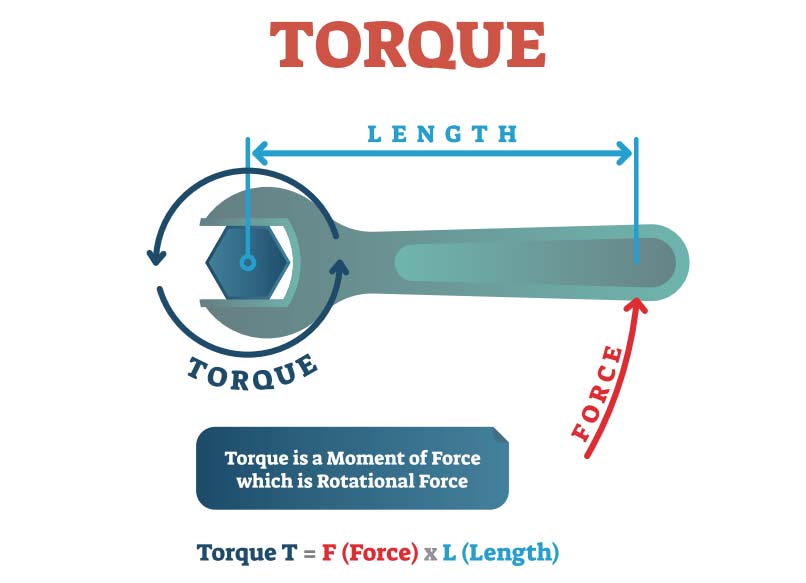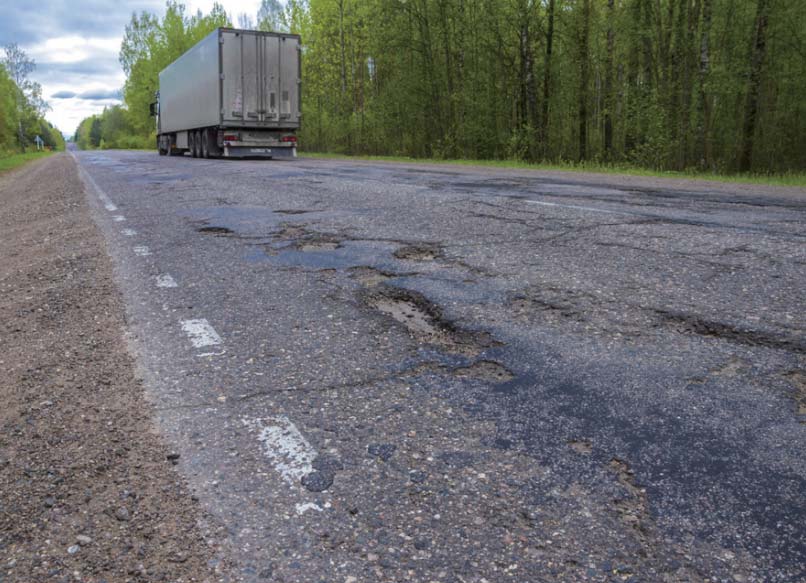Overview and application
Road surface damage is the result of a combination of factors, such as rainfall, extreme heat, geological location for seismic activities, and tires. It is because the vehicle torque is delivered to the tires and the grip rips off the road surfaces. As “force” is part of the equation when it comes to torque, therefore it is not so much of a problem with household vehicles, but for heavier trucks or semi-trailers, if you are illegally over-carrying cargo weight, it may cause tremendous damage to the road. For example, while a truck carrying 18,000 pounds is only 9 times heavier than a 2,000-pound automobile, but it causes 5,000 times the damage (truck weight and its effect on highways). This can cause the government a huge amount of money and time to repair, but most importantly, loose gravel, uneven surfaces, or potholes are dangerous, especially on highways.

Downward force is a factor when calculating torque

Freeway road surface damage
This is why you see weighing stations signaling for trucks and semi-trailers on the freeway to be checked and weighed. But weight checking is done randomly so they do not disrupt the traffic flow as for one semi-trailer to slow down and change to the outside lane to enter the weighing station may hold up the traffic behind. Our customer designed a weighing system embedded into the road that can weigh each vehicle that passes over it. Connected to overhead cameras, they can scan/ recognize the license plate and record passing vehicles. For trucks/ semi-trailers that are detected to be over their cargo weight limit, a sign further down the road will signal them to pull into the station. The benefit of this system is that it can check the weight of nearly all trucks/ semi-trailers without slowing down the traffic.
Challenges
 To deploy computer systems under the weather is always challenging, especially when it is right in the middle of the action. When deployed under the weather, the computer must endure rain or extreme heat from the sun, and being out in the open, power source availability will be scarce. On top of the conditions mentioned, positioned on the highway with 18,000 pound trucks/ semi-trailer passing through at speeds up to 100 kilometers an hour, there will be a significant amount of rumbling and vibration in the ground.
To deploy computer systems under the weather is always challenging, especially when it is right in the middle of the action. When deployed under the weather, the computer must endure rain or extreme heat from the sun, and being out in the open, power source availability will be scarce. On top of the conditions mentioned, positioned on the highway with 18,000 pound trucks/ semi-trailer passing through at speeds up to 100 kilometers an hour, there will be a significant amount of rumbling and vibration in the ground.
The computer unit must also provide enough processing power to identify/ recognize the plates and utilize wireless communication to upload the live data to a station further up the road so they can wave in the trucks/ semi-trailers that have been detected to be carrying excess cargo weight.
Solution
Our customer decided to build their weighing stations with Neousys’ NRU systems. Similar to a roadside unit, the system is mounted on the highway, connected to GMSL cameras that are capable of operating flawlessly in various lighting conditions. The GMSL cameras have IP67 waterproof characteristics, high dynamic range (>120dB HDR), auto white balance (AWB), and LED flickering mitigation (LFM), and is not affected by lighting conditions, sunny, overcast, or in the dark. The NRU series edge computer is powered by NVIDIA® Jetson AGX Xavier that offers TFLOPS inference performances, which is perfect for image recognition applications. The NRU series systems are also tested to be compliant with MIL-STD-810G to withstand shock and vibration conditions; are compact enough to fit into confined space installations; have expansion slots for wireless communication modules (LTE, 5G, etc.), and offer true wide temperature operation capabilities.






